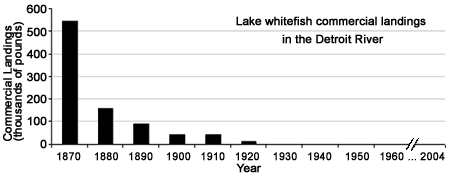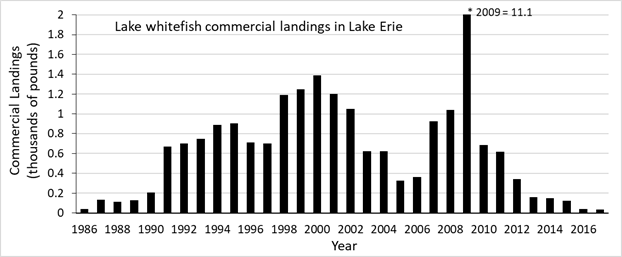Detroit River-Western Lake Erie Basin Indicator Project
Lake Whitefish Spawning
Authors
Edward Roseman, U.S. Geological Survey, eroseman@usgs.govRobin DeBruyne, University of Toledo, Robin.Debruyne@utoledo.edu
Background
During the late 19th and early 20th centuries, large numbers of lake whitefish (Figure 1) and cisco (formerly referred to as lake herring) entered the Detroit River in the fall to spawn. Whitefish prefer to spawn on rock, honeycomb limestone, gravel or sand substrates (Hart 1930, Ihssen et al. 1981). Natural bedrock (spawning grounds of lake whitefish, cisco, walleye, and trout) was blasted and removed during the construction of the Livingstone Channel from approximately 1907 to 1916. Historic reports imply that the lower river was a prolific spawning area prior to the construction of the shipping channel (Goodyear et al. 1982). The timing of this construction coincides with the demise of whitefish stock in the river; this alteration in river hydrology and habitat represents a major disconnection in the linkage between river spawning and incubation areas and productive nursery habitats in western Lake Erie. Spawning runs of lake whitefish into the Detroit River almost disappeared by the early 1900s due to overfishing and loss, degradation of habitat and eutrophication (Trautman 1957, Goodyear et al 1982, Hartman 1972).

Figure 1. Adult lake whitefish (Coregonus clupeaformis) (left) caught in November 2005 and lake whitefish eggs (right) collected in the Detroit River. (photo credit: U.S. Geological Survey)
Lake whitefish feed on organisms on the bottom of the lake, primarily on Diporeia and chironomids, in the western Lake Erie basin. They are cold stenotherms (narrow temperature tolerance), requiring cold, adequately oxygenated bottom waters for summer habitat, and relatively silt-free river or lake spawning areas for successful reproduction (Hartman 1973). Lake Erie is the southern edge of the species zoogeographical range. Lake whitefish are recognized as an indicator of ecosystem health and an integral component of the Great Lakes food web.
Status and Trends
By the 1960s and 1970s lake whitefish abundance was at an all-time low for a variety of reasons: overexploitation, predation by and competition with invasive species, degradation of water quality and habitat, and the loss of Diporeia, a major nutrient-rich food source. Reduced phosphorus loading to the lake resulted in more favorable conditions for whitefish by the early 1980s, following the implementation of the 1972 Great Lakes Water Quality Agreement (Mohr and Nalepa 2005).
The persistence of remnant self-sustaining lake whitefish stocks in Lakes Huron and Erie, coupled with habitat rehabilitation efforts, allowed the Lake Erie population to begin to recover in the early 1980s (Coldwater Task Group 2018; Roseman et al. 2012). Throughout the 1980s and 1990s the species reached above average catches in Lakes Michigan and Huron (Mohr and Nalepa 2005). Whitefish growth rates in Lake Erie after the recovery appear to be similar to rates prior to the period when populations reached all-time lows (Coldwater Task Group 2018). For Lake Erie as a whole, growth and condition of whitefish have remained stable, but current landings' values are below the range of historical means (Coldwater Task Group 2018) inhibiting achievement of a self-sustaining population that can support a viable fishery (Ryan et al. 2003).

Figure 2. Lake whitefish commercial landings in the Detroit River. Catch is measured in thousands of pounds from 1870-2004 (data from Baldwin et al. 1979 and subsequently collected by U.S. Geological Survey).
Harvest in the Detroit River exceeded a half million pounds in the late 1800s and declined through the early part of the 20th century (Figure 2). Overharvest and habitat degradation resulted in very low catches after about 1910. The decline of the lake whitefish coincided with the decline of the walleye, blue pike, and cisco. The Lake Erie whitefish fishery lasted in the east end of the lake until the 1960s. After an absence of approximately 20 years, commercial fishing for lake whitefish in Lake Erie increased to over one million pounds per year during the late 1990s and early 2000s (Figure 3). Landings during 2010 through 2017 have declined slightly to approximately 270,000 pounds. This is evidence that a large proportion of young Lake Erie lake whitefish are dying prior to being large enough for harvest. The cause of this population reduction is currently unknown.

Figure 3. Lake whitefish commercial landings in Lake Erie. Catch is measured in millions of pounds from 1986-2017 (data from Coldwater Task Group 2018).
Since 2005, when U.S. Geological Survey (USGS) researchers in partnership with the U.S. Fish and Wildlife Service documented lake whitefish spawning in the Detroit River (Roseman et al. 2007), annual surveys of fall egg deposition and spring larval drift show continued use of the Detroit River for reproduction (Roseman et al. 2012). Assessments of constructed fish spawning reefs showed use by lake whitefish, but that egg abundances were generally higher at natural rocky river bottoms (Fischer et al. 2018). Estimates of larval lake whitefish exported from the Detroit River to western Lake Erie ranged from 29 million in 2010 to 83 million in 2011 (Roseman et al. In press). Continued monitoring and research will focus on measuring the contributions of Detroit River lake whitefish to the overall Lake Erie population using fisheries stock assessment models and genetics.
Management Next Steps
It is recommended that management agencies continue to monitor lake whitefish populations in the Detroit River and Lake Erie to ensure the continued recovery and achievement of sustainable stocks. Emphasis should continue to be placed on controlling invasive species, such as dreissenids, which cause food-web disruptions that influence whitefish abundance, growth, and condition. Management agencies should continue to assess maturation and fish use of spawning habitats in the Detroit River following completion of the fish spawning habitat constructed during 2010 – 2018 (Vaccaro et al. 2016).
Research/Monitoring Needs
Through intensive research and standardized assessment surveys, scientists continue to learn more about lake whitefish life history, habitat requirements, and their ecological niche in Lake Erie and its tributaries, including the Detroit River. However, current conditions of the physical and biological characteristics of essential whitefish habitat and key information on yield, diet, growth, recruitment, and reproduction rates are still unknown or understudied. These types of information are critical for the successful management of fisheries in the Detroit River and its connecting waters. Further, efforts to rehabilitate fisheries habitat in the Detroit River rely on knowledge of habitat availability and function to use as a benchmark for restoration goals (Coldwater Task Group 2018). Research projects should be designed to measure biotic and abiotic factors influencing different life history stages of lake whitefish. Such research could include:
- Development of Biological Reference Points for Lake Erie lake whitefish (Coldwater Task Group 2018);
- identifying spawning sites of multiple fish species;
- describing the physical characteristics of spawning areas;
- quantifying relative egg abundance and survival;
- assessing egg viability and physiological condition;
- assessing predation of fish eggs by fishes and invertebrates;
- assessing spawning stock characteristics to include genetics; and
- exploring nursery habitat in the river.
References
- Baldwin et al. 1979. Commercial fish production in the Great Lakes. Great Lakes Fisheries Commission Technical Report Number 3, Ann Arbor, MI.
- Coldwater Task Group. 2018. Report of the Lake Erie Coldwater Task Group, March 2018. Presented to the Standing Technical Committee, Lake Erie Committee of the Great Lakes Fishery Commission. Markham, Ontario.
- Fischer, J.L., J.J. Pritt, E.F. Roseman, C.G. Prichard, J.M. Craig, G.W. Kennedy, and B.A. Manny. 2018. Lake sturgeon, lake whitefish, and walleye egg deposition patterns with response to fish spawning substrate restoration in the St. Clair-Detroit River System. Transactions of the American Fisheries Society 147: 79-93. DOI: 10.1002/tafs.10016.
- Goodyear, C.D., T.A. Edsall, D.M. Ormsby-Dempsey, G.D. Moss, and P.E. Polanski. 1982. Atlas of spawning and nursery areas of Great Lakes fishes. FWS/OBS-82/52. Volumes 1-14 Washington, DC: U.S. Fish and Wildlife Service.
- Hart, J.L. 1930. Spawning and early life history of whitefish (Coregonus clupeaformis) in the Bay of Quinte, Ontario. Contributions to Canadian Biology and Fisheries 40:165-214.
- Hartman, W.L. 1972. Lake Erie: effects of exploitation, environmental changes, and new species on the fishery resources. Journal Fisheries Research Board of Canada 29: 931-936.
- Hartman, W.L. 1973. Effects of exploitation, environmental changes, and new species on the fish habitats and resources of Lake Erie. Great Lakes Fishery Commission Technical Report Number 22, Ann Arbor, MI.
- Ihssen, P.E., D.O. Evans, W.J. Christie, J.A. Rechahn, and D.L. DesJardine. 1981. Life history, morphology, and electrophoretic characteristics of five allopatric stocks of lake whitefish (Coregonus clupeaformis) in the Great Lakes region. Canadian Journal of Fisheries and Aquatic Sciences 38:1790-1807.
- Knight, R.L. 1997. Successful interagency rehabilitation of Lake Erie walleye. Fisheries 22:16-17.
- Mohr, L.C., and T.F. Nalepa (Editors). 2005. Proceedings of a workshop on the dynamics of lake whitefish (Coregonus clupeaformis) and the amphipod Diporeia spp. in the Great Lakes. Great Lakes Fishery Commission Technical Report 66. pp. 5, 100.
- Roseman, E.F., G.W. Kennedy, J. Boase, B.A. Manny, T.N. Todd, and W. Stott. 2007. Evidence of lake whitefish spawning in the Detroit River: implications for habitat and population recovery. Journal of Great Lakes Research 33:397-406.
- Roseman, E.F., G. Kennedy, B.A. Manny, J. Boase, and J. McFee. 2012. Life history characteristics of a recovering lake whitefish Coregonus clupeaformis stock in the Detroit River, North America. Advances in Limnology 63(2012):477-501.
- Roseman, E.F., M. DuFour, J. Pritt, J. Fischer, R.L. DeBruyne, and D. Bennion. In press. Export of pelagic fish larvae from the Detroit River. Accepted to Advances in Limnology, accepted June 2018.
- Ryan, P.A., R. Knight, R. MacGregor, G. Towns, R. Hoopes, and W. Culligan. 2003. Fish-community goals and objectives for Lake Erie. Great Lakes Fish. Comm. Spec. Publ. 03-02. 56 p.
- Trautman, M.B. 1957. The Fishes of Ohio. Ohio State University Press. Columbus, Ohio. xviii, pp. 683.
- Vaccaro, L., D. Bennion, J. Boase, M. Bohling, J. Chiotti, J. Craig, J. Fischer, G. Kennedy, B. Manny, J. Read, and E.F. Roseman. 2016. Science in action: Lessons learned from fish spawning habitat restoration in the St. Clair and Detroit Rivers. University of Michigan Water Center Report, Ann Arbor, MI.
Contact Information regarding Lake Whitefish Spawning
Edward Roseman
U.S. Geological SurveyE-mail: eroseman@usgs.gov
Robin DeBruyne
University of ToledoE-mail: Robin.Debruyne@utoledo.edu